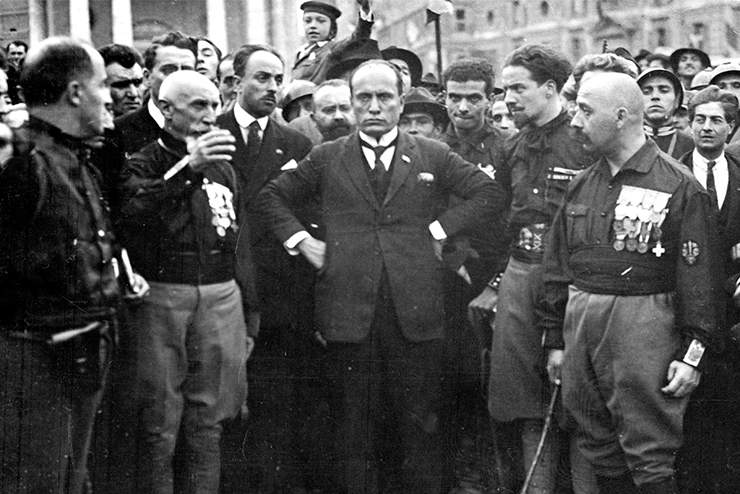The right is often accused of fascist tendencies in many of today’s political diatribes. A typical response is for the right to return the same accusation toward the left, a fact Edward Ring explores in a recent article for American Greatness, citing Jonah Goldberg’s famous book Liberal Fascism.
Ring provides an intellectual service by bringing up the relationship between fascism and the woke left. Having written books on both fascism and antifascism—focusing on the woke left in the latter—I would agree that there is a connection between the ideologies in question, but not the ones Ring points out via Goldberg’s Liberal Fascism. Indeed, and unfortunately, Goldberg’s book is not a particularly useful entry point for discussing this link for several reasons.
For starters, Goldberg goes too far in sticking the fascist label on the Democratic party, particularly the not very likeable Clintons. He also has the tendency to depict early advocates of the American welfare state as protofascists, especially if they were Democrats. Conversely, Republicans who favored eugenics or endorsed the expansion of welfare state measures are spared the fascist label, even if their positions were indistinguishable from those of their Democratic colleagues. Nor is there any indication that Goldberg, who seems to accept most of our present welfare state, considers himself to be a fascist for doing so.
Goldberg’s disfiguring fascist label does not in fact fit his subjects in the Democratic party because, as regrettable as we might find some of their stands, they were not fascists. They were American politicians and would-be reformers who weakened the liberal constitutional structure bequeathed by America’s founders. We may deplore what they did, but that is different from Goldberg’s attempt to show his subjects were fascists.
We should also avoid Goldberg’s practice of throwing together the characteristics of different interwar regimes, e.g., those of fascist Italy and Nazi Germany, and then presenting readers with a supposedly unified picture of fascism, which can then conveniently be applied to the Democratic Party. All Western societies, as they urbanized and industrialized, developed administrative states that enacted social measures like those of our progressives and New Dealers. Although we may not like this course of events, those behind it were not fascists. Nor do social democrats qualify as fascists, even if the governments they produce destroy our freedom and reduce our virtues.
What Goldberg characterizes as general fascist characteristics were often introduced by nonfascist governments because of economic crises and popular demand. For example, efforts to construct a fascist state in Italy between 1924 and 1929 barely affected economic and vocational arrangements. After the Great Depression set in, the Italian government, like the American, British, and other Western states, distributed subsidies and promoted public works programs. Although Italian fascists did not engage in radical redistributionist economics, they exalted as their organizational model a corporate state, overseen by a leader who embodied the will of the nation.
Likewise, Nazi Germany was not a typical fascist regime, but a particularly vicious totalitarian one, which borrowed freely from the trappings of Mussolini’s government as well as from Stalin’s regime. Hannah Arendt points out that Hitler might have been imitating Stalin by creating concentration camps for presumed enemies of the state.
Hatred of the most famous of Hitler’s presumed enemies of the state, the Jews, is often thought to be a characteristic of fascism. Yet this is not always the case. Many Italian Jews had been members of the Fascist Party of Italy, and Mussolini’s measures to exclude Jews from party membership and the professions was very unpopular with leading fascists, like Dino Grandi and Giovanni Gentile. Anti-Jewish measures in fascist Italy were not introduced until October 1938 and seem to have been done in imitation of the far harsher German measures after Mussolini stupidly threw in his lot with Hitler.
Fascists were also revolutionary nationalists, who stressed the recovery of national glory. They were frequently expansionists because they were intent on recovering lost empires and the respect of the “plutocratic democracies,” which Mussolini denounced as “decadent.”
It is hard to see the persistence of these fascist characteristics in today’s woke ideology or practices. But there are overlaps between these historical actors.
Fascists and our woke rulers are equally dubious revolutionaries who have protected those in power while pretending to remake society. Like fascists and communists, our woke politicians and their corporate capitalist friends and allies in the Deep State depict themselves as never quite having attained power and being forced to struggle against an insidious enemy. The campaign of intimidation that the Biden administration is waging against “right-wing extremists” and the purported danger of another “insurrection” after Jan. 6 reminds me not only of Mussolini’s attempted intimidation of exiled opponents, but also of Hitler’s efforts to rid himself of competitors on the Night of the Long Knives.
Another characteristic of interwar totalitarianism—and one most definitely found in Nazi Germany—that has come back to haunt us is the unleashing of systematic violence as a warning to opposition. The plundering and gun violence of Black Lives Matter and Antifa financed by Democrats last summer was reminiscent of the activities of the Nazi Brown Shirts as Hitler was taking power.
One does not have to cite New Deal measures or Democratic fans of eugenics to underscore the present totalitarian threat. More frightening examples now surround us.
Image Credit:
Wikimedia Commons-public domain

Leave a Reply